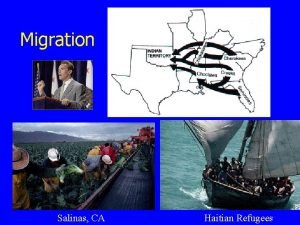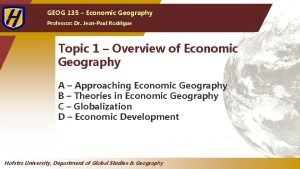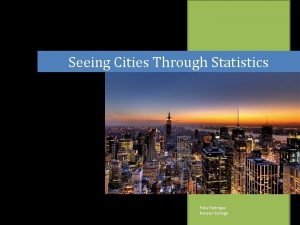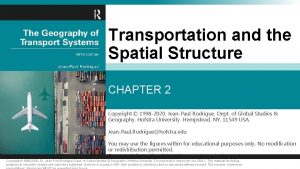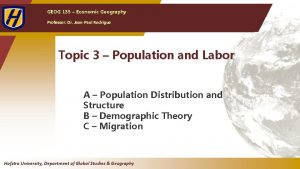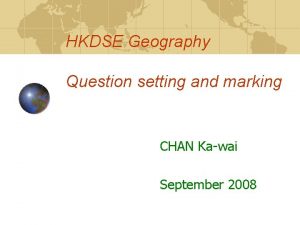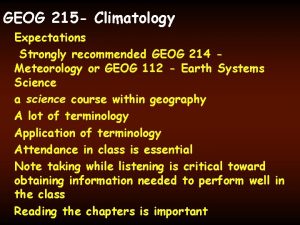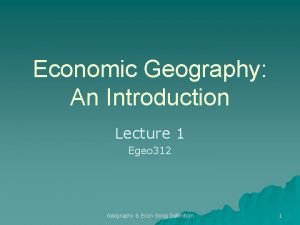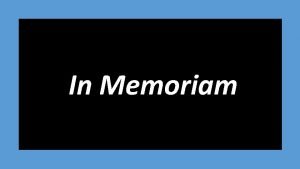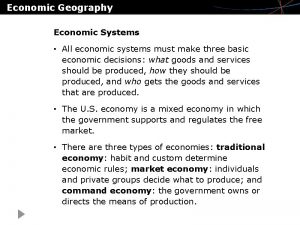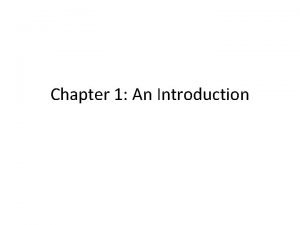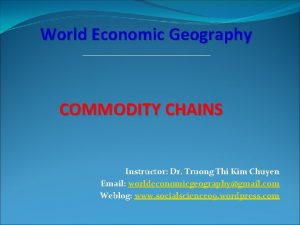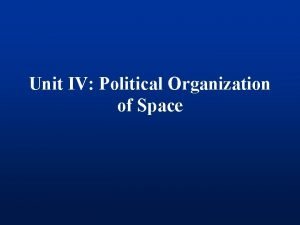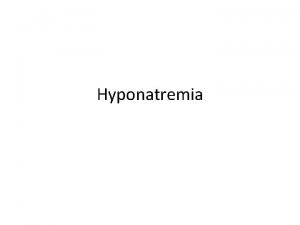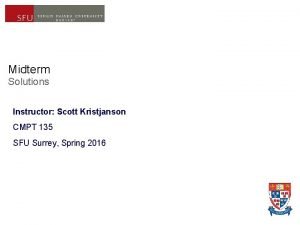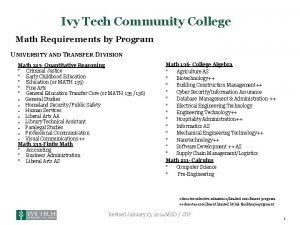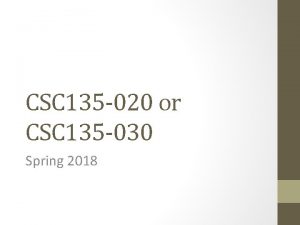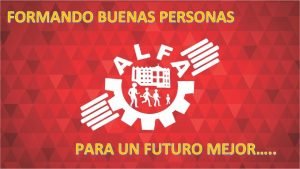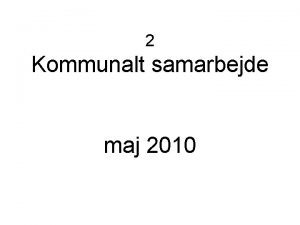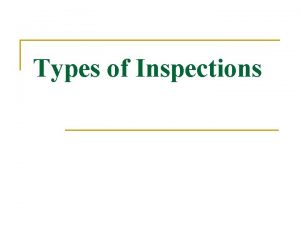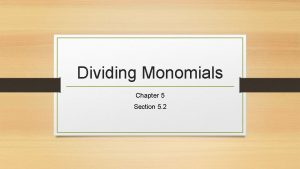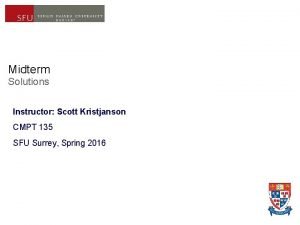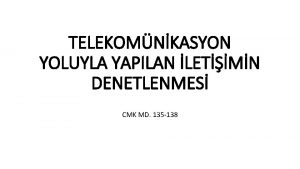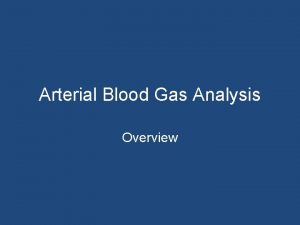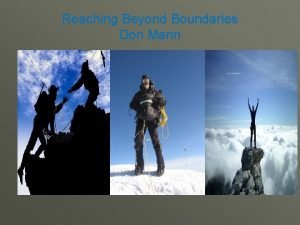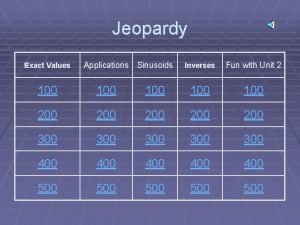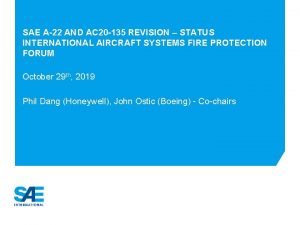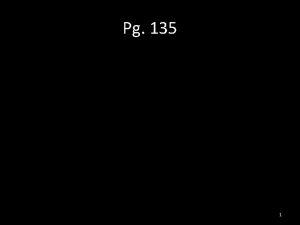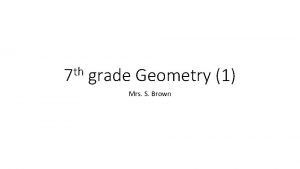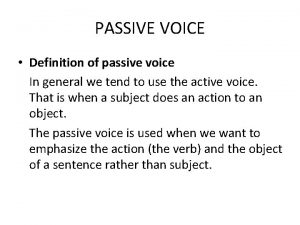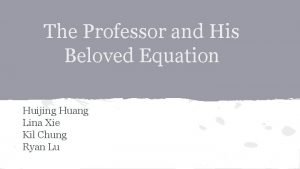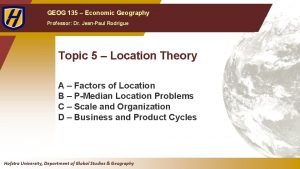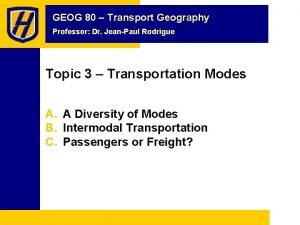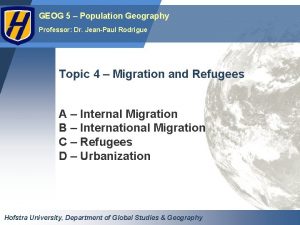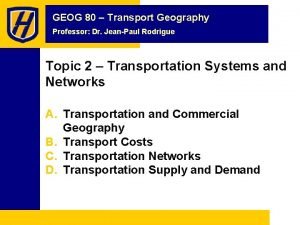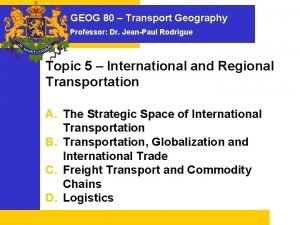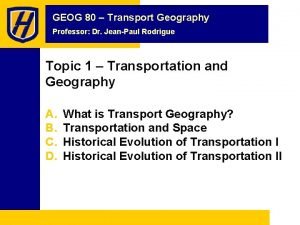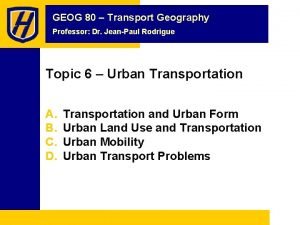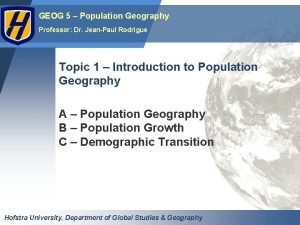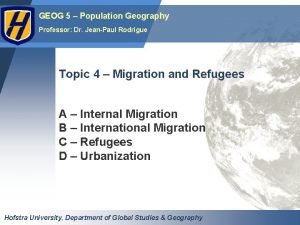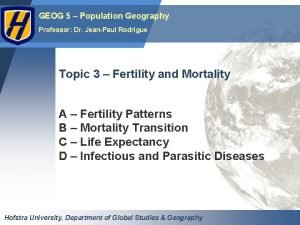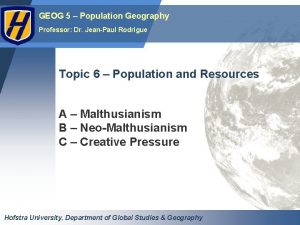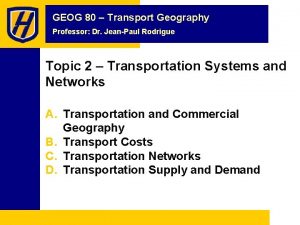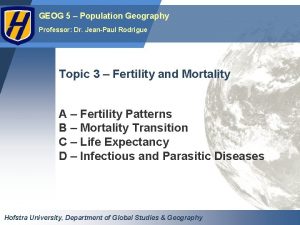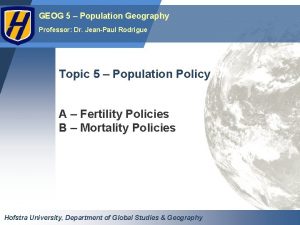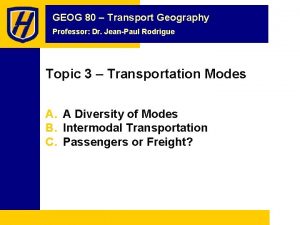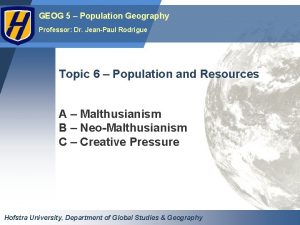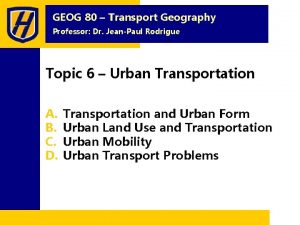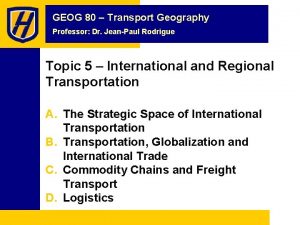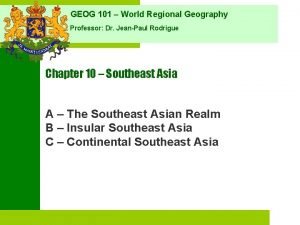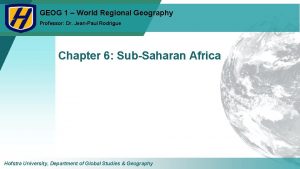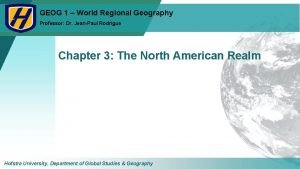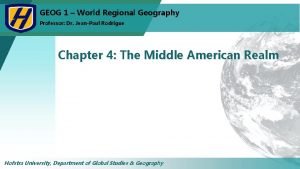GEOG 135 Economic Geography Professor Dr JeanPaul Rodrigue






































































- Slides: 70

GEOG 135 – Economic Geography Professor: Dr. Jean-Paul Rodrigue Topic 1 – Overview of Economic Geography A – Approaching Economic Geography B – Theories in Economic Geography C – Globalization D – Economic Development Hofstra University, Department Global Studies & Geography Hofstra University, of of Global Studies & Geography

The world is not random… the spatial order of the economy What is located where, why, how? © Dr. Jean-Paul Rodrigue

Tra Added Value nsp ort a nd tel eco mm un ica tio n An Economic Hierarchy of Activities Quaternary • Information and research • Management and decision making Tertiary • Retail and wholesale • Personal services Secondary • Manufacturing and processing • Power generation Primary • Agriculture • Gathering and extractive industries © Dr. Jean-Paul Rodrigue

The Primary Sector (Agricultural Fields in Paraguay) About 37% of the world’s land devoted to agriculture Why are there agricultural land patterns? © Dr. Jean-Paul Rodrigue

The Primary Sector (Open Pit Copper Mine, Utah) What copper is used for? © Dr. Jean-Paul Rodrigue

The Secondary Sector (Chicago) Why Chicago is a manufacturing hub? © Dr. Jean-Paul Rodrigue

Tertiary Sector (West Edmonton Mall) On which principles a shopping mall is set on? © Dr. Jean-Paul Rodrigue

The Tertiary and Quaternary Sectors (Hong Kong Skyline) Why buildings in a central business district are built vertically? © Dr. Jean-Paul Rodrigue

The Tertiary Sector: (Container Yard, Veracruz) What are containers used for? © Dr. Jean-Paul Rodrigue

The Tertiary Sector (Temperature Controlled Urban Delivery Truck) Why are home deliveries increasing? © Dr. Jean-Paul Rodrigue

A - APPROACHING ECONOMIC GEOGRAPHY 1. 2. 3. 4. Defining Economic Geography Economics and Economic Geography Space, Place and Scale Themes for Approaching Economic Geography © Dr. Jean-Paul Rodrigue

Defining Economic Geography ■ Subdiscipline of geography concerned about: • The spatial organization and distribution of economic activities: • • Production (primary, secondary, tertiary). Consumption. Transportation / distribution. Telecommunication. • The use of the world’s resources. • The geographic origins, structure, and dynamics of the world economy. • Patterns: Where activities are and how they are arranged. • Processes: Why and how activities have located. • Impacts: How activities have an impact on each-other and geography. Define economic geography and provide an example of the spatial characteristic of © Dr. Jean-Paul Rodrigue

Economic, Transport and Commercial Geography Activities Sphere of Locations Economic Geography Commer cial Transactions Geograp Sphere of Transactions hy Space Transpor t Geograp hy Read this content Circulation Sphere of Circulation © Dr. Jean-Paul Rodrigue

Global Manufacturing, 2015 Read this conte 26. 7% in 1970 16. 5% in 2015 © Dr. Jean-Paul Rodrigue

World’s Largest Cities, 2015 Read this content © Dr. Jean-Paul Rodrigue

World’s Major Container Ports, 2015 Read this content © Dr. Jean-Paul Rodrigue

Passenger Traffic at the World’s Largest Airports, 2010 Read this content © Dr. Jean-Paul Rodrigue

Global Submarine Cable Network Read this content © Dr. Jean-Paul Rodrigue

Economics and Economic Geography Explain the main differences between economics and economic geography. Economics Economic Geography • People are behaving in a rationale manner (homo economicus). • People and firms are competing on markets where supply and demand reach an equilibrium. • A market economy operates according to laws and principles. • The market is often considered as aspatial. • Universalism: laws and principles work everywhere. • People are behaving differently according to their context (homo geographicus). • Economies must take place. • Markets have locations and geography is influencing supply and demand. • Laws and principles are disrupted by geographical, social and political factors. • Geographical diversity challenges universalism. © Dr. Jean-Paul Rodrigue

Location, Place and Scale ■ Location • Includes physical distance and area. • Where an activity is occurring. • Involves territory, location, flows and unevenness. ■ Place • Specificity or uniqueness of places (a form of identity). • Involves an embeddedness of economic processes in environmental, social, cultural, institutional and political contexts. ■ Scale • Help understand the hierarchy of places and human activities. • From local to global scale. Explain the differences between location, place and scale in economic geography. © Dr. Jean-Paul Rodrigue

Location, Place and Scale ■ Forms of production are associated with places • • New York and London finance and business services. Los Angeles Hollywood and the film industry. Silicon Valley internet and social media technologies. The Pearl River Delta with high tech manufacturing. © Dr. Jean-Paul Rodrigue

Global Space / Time Convergence: Days Required to Circumnavigate the Globe 400 350 (1500 -1840 )Average speed of horse and cart: 4 km/hr Average speed sail ships: 16 km/hr 360 300 (1850 -1930) Average speed of trains: 100 km/hr Average speed of steamships: 25 km/hr Days 250 200 150 (1950) Average speed of airplanes: 480 -640 km/hr 150 100 (1970) Average speed of jet planes: 800 -1120 km/hr 100 (1990) Numeric transmission: instantaneous 60 50 Space / Time Convergenc e 3 2 1 1950 1975 2000 0 1850 1875 1900 1925 Read this conte © Dr. Jean-Paul Rodrigue

Themes for Approaching Economic Geography 1 ■ Historical specificity of geography • Difficult to separate spatial and temporal processes. • The current situation the outcome of past decisions: • • Firms. Individuals. Organizations. Governments. • Economic geography is spatially and temporarily constructed. © Dr. Jean-Paul Rodrigue

Spanish and Portuguese Empires (1581 -1640) 1 Read this content © Dr. Jean-Paul Rodrigue

Themes for Approaching Economic Geography 2 ■ Interconnectedness of regions • Places do not exist in isolation from one another. • Networks of locations; implies links. • Types of linkages: • • Biophysical (e. g. winds, sea currents, pollution). People (e. g. migration, commuting). Capital (e. g. investments, remittances). Goods (e. g. trade, supply chains). • Power relations (e. g. trade agreements). © Dr. Jean-Paul Rodrigue

Global Net Migration (2010 -2015) 2 Read this content © Dr. Jean-Paul Rodrigue

Main Origin of Imports by Nation, 2018 2 © Dr. Jean-Paul Rodrigue

Themes for Approaching Economic Geography 3 ■ Interpenetration of human and biophysical systems • Natural resources impact economic opportunities: • Climate, topography, soils, vegetation, minerals, water resources. • Agriculture, Mining, Logging. • People and economic activities also impact biophysical systems: • • • Irrigation. Deforestation. Desertification. Pollution. Climate change. • Long history of interdependencies since the agricultural revolution. © Dr. Jean-Paul Rodrigue

Most Suitable Cereal 3 © Dr. Jean-Paul Rodrigue

Themes for Approaching Economic Geography 4 ■ Importance of culture in the creation of social and spatial relations • Influence of culture on economic behavior. • Culture dictates what is desirable and acceptable; consumption norms. • Political economy reflective of culture; distribution of power and wealth. • Gender relations (workforce participation). © Dr. Jean-Paul Rodrigue

World’s Major Cultural Regions 4 Slavic-Orthodox Western Islamic Confucian Hindu Latin American African Islamic Western © Dr. Jean-Paul Rodrigue

Essay: Themes of Economic Geography Elaborate about the four main themes of economic geography. © Dr. Jean-Paul Rodrigue

B – THEORIES IN ECONOMIC GEOGRAPHY 1. Location Theory 2. Political Economy © Dr. Jean-Paul Rodrigue

Main Theoretical Foundations in Economic Geography Location theory Explaining the distribution and patterns of economic activity across space. Quantitative perspective. Behavioral economics Range of factors influencing decision making. Impacts of culture and psychology (irrational behavior). Political economy Importance of social and political relations (concentration and distribution of wealth). Marxist perspective (role of the state as an economic agent). New economic geography Look at economic globalization. Location of production in space (relations). Role of factors such gender, race, age, religion and culture. © Dr. Jean-Paul Rodrigue

Location Theory ■ Concept of location • Absolute location (coordinate system). • Relative location (referring to other locations). ■ Definition • Analyzing location decisions of firms and individuals. • What locates where? • Looking for a formulation / rules of behavior. • Why? © Dr. Jean-Paul Rodrigue

Basic Location Factors Read this content Land, utilities, visibility, transportation (local access), Micro (local) amenities Labor, materials, energy, markets, suppliers / Meso (regional) customers Capital, subsidies, regulations, taxation, Macro (national) technology Location Site Accessibility Socioeconomic Environment © Dr. Jean-Paul Rodrigue

Location Theory ■ Relevance of geography • Location is a resource multiplier: • Using resources more effectively. • A city is a more effective production and consumption structure. • Some locations have higher sale potential; they differ mainly because of their accessibility. • Accessibility can be a proxy for the value of space. • A location can be a resource in itself: • Bottleneck rent effect on flows (canals, bridges, tunnels). • Capturing rent for right of passage (plus construction and maintenance of infrastructure). What is location theory and what are the main location factors? © Dr. Jean-Paul Rodrigue

Political Economy ■ Political economy • Power structure and wealth distribution within a society. • “Who gets what, when, where and why”. • Institutions behind this structure and distribution. Power Wealth Distribution Hierarchy Traditional Economies Lords Families / Clans Feudalism Fixed / Hereditary Capitalism Suffrage Individuals / Corporations Market Flexible / Competence Command Economies Bureaucracy State Central planning Fixed / Elites © Dr. Jean-Paul Rodrigue

Political Economy ■ Two ideological pathologies • Communism and socialism as pathologies of capitalism. • Individual labor (and sovereignty) does not belong to the individual, but the collective. • A society is composed of oppressors and oppressed (culture of victimhood). • Communism / socialism: • Group identity based on social class (e. g. bourgeoisie vs proletariat). • Cultural Marxism: controversial term that frames racial, sexual, cultural identities in a ‘hierarchy of oppression’. • Seek equality of outcome through forced redistribution. • Private property not allowed and economic decisions centrally planned. • National socialism: • Group identity based on nation/race/ethnicity. • Private property allowed as long as it supports the state’s objectives. © Dr. Jean-Paul Rodrigue

Political Economy ■ Pathological consequences • Socialism comes with economic failure, social deprivation and political suppression: • Those outside the group identity are ‘oppressors’ that need to be ‘reeducated’ or purged (cancel culture). • Resources and wealth forcefully confiscated and redistributed. • The political class becomes the wealthy class. • The most ruthless rule; socialists / communists do not support the poor, they hate the rich / competent (resentment at the core of socialist and communist ideologies). • Little incentive to innovate; people are poorly served. • Guilt by association. • Examples: • 100 -120 million killed by various socialist regimes since 1917. • Russia: Soviet famine (1932 -33), Great purges, deportation of minorities, the Gulag Archipelago. © Dr. Jean-Paul • China: Post revolution purges (1949 -55), Great Leap Forward (1958 -59), the Rodrigue

The Ideological Pathology of Socialism © Dr. Jean-Paul Rodrigue

The Output of Capitalism versus Communism BMW 850, West Germany 1989 Trabant, East Germany 1989 © Dr. Jean-Paul Rodrigue

Political Economy ■ The rise of capitalism • The general demise of command traditional economies in the face of globalization. • Economic geography as the study of capitalist landscapes: • • • Individual choice and ownership of labor. Private property. The search for innovation and efficiency. Profit as a driver (capital accumulation). Competition through processes and locations. • Capitalism emerged in the 15 th century, diffused with colonialism and accelerated with globalization. Explain the nature of capitalism and the circular flows of capital. © Dr. Jean-Paul Rodrigue

The Circular Flow in the Capitalist System (Market Economy) $ to pay for resources Goods & Services (consumption resources) Businesses & Government (production) (sales) Resource Market (prices) Income from work Savings & Investment: Capital Markets Goods & Services $ from product market (sales) Product Market (prices) Labor (production - labor) Households (consumption) Goods & Services $ to pay for consumption Public Goods: Taxation & Provision © Dr. Jean-Paul Rodrigue

The ‘Oppression’ of Capitalism: The World as 100 People since the early 19 th Century © Dr. Jean-Paul Rodrigue

C – NEW ECONOMIC GEOGRAPHY (GLOBALIZATION) 1. Economic Globalization 2. Transnational Corporations © Dr. Jean-Paul Rodrigue

Economic Globalization ■ Growing interdependencies • Individuals and corporations impacted by processes taking place elsewhere. ■ Key trends impacting interdependencies • • • International finance. The role of transnational corporations. Foreign direct investments. Global value chains. Outsourcing and offshoring in the service sector. Global tourism. What is economic globalization and what are its main driving forces? © Dr. Jean-Paul Rodrigue

The Drivers of Economic Globalization: Connecting Different Chains Integration • Regulatory chains. • Harmonization of regulatory regimes. • Trade agreements. Production Transportati on • Transport chains. • Supply / value • Containerization. chains. • Transborder • Offshoring. transportation. • Global production networks. Standards Transactions • Information chains (ICT). • Investment capital. • Credit for transactions. © Dr. Jean-Paul Rodrigue

Economic Integration Levels, 2015 Read this cont © Dr. Jean-Paul Rodrigue

Examples of Globalization in the Service Sector Driver Response Retail Increase in disposable income Cultural homogenization Emergence of brand names Chain stores Global products Tourism Increase in disposable income Available leisure time Affordable air travel Mass tourism Chain hotels / resort areas Telecommunication Technological innovations (WWW, mobile) Privatization (mostly) Ubiquitous networks and access Global telecom carriers © Dr. Jean-Paul Rodrigue

International Tourists Arrivals and Receipts, 1950 -2017 1600 1400 Arrivals (millions) Receipts (billions of current $US) 1200 1000 800 600 400 200 Read this content 16 20 13 20 10 20 07 20 04 20 01 20 98 19 95 19 92 19 89 19 86 19 83 19 80 19 77 19 74 19 71 19 68 19 65 19 62 19 59 19 56 19 53 19 19 50 0 © Dr. Jean-Paul Rodrigue

Millions Diffusion of Telecommunication Services, 1985 -2018 9, 000 Cellular Phone Subscribers 8, 000 Fixed Broadband Subscriptions Mobile Broadband Subscriptions 7, 000 Internet Users 6, 000 5, 000 4, 000 3, 000 2, 000 1, 000 0 1981 1983 1985 1987 1989 1991 1993 1995 1997 1999 2001 2003 2005 2007 2009 2011 2013 2015 2017 Read this content © Dr. Jean-Paul Rodrigue

Corporations in the Global Economy ■ Multinational corporation (MNC) • Provides goods and/or services. • A corporation that takes a global approach for: • Its inputs (raw materials, parts). • Its outputs (customers). • Different parts of the industrial system are located in places where they are the most productive. Inputs MNC Outputs © Dr. Jean-Paul Rodrigue

What Multinational Corporations are Trying to Achieve to Compete? Lower production costs • One of the main goals of a corporation. Exploitation of comparative advantages. Stability of prices and deliveries • The rationale of low costs must also take account of price changes of raw materials and parts. Risky to relocate (long-term investment) to take advantage of conditions that can change on the short term. Product quality • Performance, service and maintenance. A quantitatively competitive product has limited advantages if not qualitatively competitive. Production and distribution flexibility • Facing changes in the demand confers a notable advantage. © Dr. Jean-Paul Rodrigue

Types of Multinational Corporations by Strategy Raw Materials Seekers • Lower input costs • Resource acquisition • First MNCs to emerge Market Seekers • Achieve economies of scale • Expand market • Large investors Minimal Cost Seekers • Look for comparative advantages • Lower production and distribution costs • Remain competitive © Dr. Jean-Paul Rodrigue

The World’s 20 Largest Corporations by Revenue, 2017 ($US millions) EXOR Group AT&T General Motors Read this content Daimler Glencore Samsung Electronics CVS Health United. Health Group Explain what are multinational corporations, their role and function. BP Mc. Kesson Exxon Mobil Apple Berkshire Hathaway Royal Dutch Shell Volkswagen Toyota Motor China National Petroleum Sinopec Group State Grid Walmart 0 50, 000 100, 000 150, 000 200, 000 250, 000 300, 000 350, 000 400, 000 450, 000 500, 000 © Dr. Jean-Paul Rodrigue

D – ECONOMIC DEVELOPMENT 1. The Notion of Development 2. Wealth Disparities © Dr. Jean-Paul Rodrigue

The Notion of Development ■ What is development? • Development is a process; a mean towards an end. • Improvement of the welfare of the population: • Development is about people, not necessarily the economy. • Create an enabling environment for people; economic opportunities. • Long term process; takes place over decades. • Different societies can have different development goals: • • Promote private accumulation of wealth. National and collective interests. Reducing national inequalities. “Hard” (e. g. infrastructure) versus “soft” (e. g. education) approaches. © Dr. Jean-Paul Rodrigue

The Notion of Development ■ Development goals • • • Adequate food and water supplies. Healthcare system. Sanitation and disease control. Providing transport and communication infrastructure. Employment opportunities. Educational opportunities. Rule of law and protection of rights and private property. Access to housing. Low environmental impact of society. ■ Conditions • Appropriate social, political, legal and economic conditions. © Dr. Jean-Paul Rodrigue

The Notion of Development Physical Capital • Infrastructures and resources that can be used in a productive manner. • Public utilities: • Energy, telecommunications, water supply and waste disposal. • Public works: • Roads, dams, irrigation canals. • Transport infrastructures: • Ports, airports, railways, public transit systems. Human Capital • Aggregate levels of education, training, skills, and health in a population. • Development of human capital: • Supported by education systems. • Reproduce and improve the productivity of the labor force. • Information economy: • Human capital a resource that differentiates nations. • Not always because of wage differences, but because of differences in © Dr. Jean-Paul Rodrigue capabilities.

The Notion of Development Explain the main conditions and outcomes of economic development Conditions Outcomes Social Political -Health -Rights -Education -Equity -Quality of life -Rule of law Economic Physical capital Human Capital -Employment -Surplus Development © Dr. Jean-Paul Rodrigue

Waves of Economic Development Pace of innovation Water power Textiles Iron Mechanization Commerce 1785 Steam Rail Steel Cotton 1 st Wave 60 years Automation Digital networks. Robotics Software Digitalization Sustainability Petrochemicals. New Media Electricity Biotechnology Electronics Chemicals Aerospace Internal combustion engine 2 nd Wave 1845 55 years 3 rd Wave 1900 50 years 4 th Wave 5 th Wave 1950 40 years 6 th Wave 199030 years (? ) 2020 25 years (? ) Read this content © Dr. Jean-Paul Rodrigue

2. Wealth Disparities ■ Inequalities • Large differences in wealth and quality of life around the world. • Differences between nations (mostly between developed and developing countries). • Differences within societies. • Inequalities not linked with a particular political system. • Capitalism rewards innovation and competence (equality of opportunities). • Socialism aims at removing differences between individuals and groups (equality of outcome). ■ Trends • Economic development is linked with global inequalities: • Reinforces the differences between countries and even within countries themselves. • 1% of the global population accounts for about 44% of the world’s© Dr. wealth. Jean-Paul Rodrigue

Distribution of Global Wealth, 2018 © Dr. Jean-Paul Rodrigue

Global Gross Domestic Product and Human Development Index, 2015 Read this content © Dr. Jean-Paul Rodrigue

Share of the World GDP, 2017 (Current USD) Rest of the world 40% France 3% India 3% United Kingdom 3% United States 24% Germany 5% Japan 6% China 15% © Dr. Jean-Paul Rodrigue

World Nominal GDP, 2007, 2016 (in billion USD) Mexico Spain South Korea Australia Canada Russia India Italy Brazil France United Kingdom Germany Japan China (PRC) United States 0 4, 000 8, 000 2007 12, 000 16, 000, 000 2016 © Dr. Jean-Paul Rodrigue

Countries with More than Half of Population in Extreme Poverty, 2011 (less than $1. 25 per day) Mali Sierra Leone Republic of Congo Angola Haiti Nepal Burkina Faso Dem. Rep. of Congo Mozambique Chad Central African Republic Swaziland Zambia Nigeria Madagascar Tanzania Malawi Rwanda Burundi Liberia 0. 0 10. 0 20. 0 30. 0 40. 0 50. 0 60. 0 70. 0 80. 0 90. 0 © Dr. Jean-Paul Rodrigue

The problem with equity is that the only possible equal ground is the lowest common denominator © Dr. Jean-Paul Rodrigue

Essay: Inequalities Economic inequalities are a controversial issue. Provide some evidence about how inequalities are taking place between and within societies. © Dr. Jean-Paul Rodrigue
 Jean-paul rodrigue hofstra university
Jean-paul rodrigue hofstra university Jean-paul rodrigue
Jean-paul rodrigue Jean-paul rodrigue
Jean-paul rodrigue Pete kenyon
Pete kenyon Jean-paul rodrigue
Jean-paul rodrigue Jean paul rodrigue
Jean paul rodrigue Dr. jean-paul rodrigue
Dr. jean-paul rodrigue Promotion from assistant to associate professor
Promotion from assistant to associate professor Geog 312 sfu
Geog 312 sfu Hkdse geography 2020
Hkdse geography 2020 Unit 1 geog. of ga/ga’s beginnings
Unit 1 geog. of ga/ga’s beginnings Geog 214
Geog 214 Free floating subdivisions
Free floating subdivisions Geog
Geog Samuel haskell
Samuel haskell Economic growth vs economic development
Economic growth vs economic development Economic development vs economic growth
Economic development vs economic growth Economics unit 1 lesson 2 difficult choices
Economics unit 1 lesson 2 difficult choices Types of economic geography
Types of economic geography Economic geography
Economic geography Geography
Geography Human and economic geography
Human and economic geography Exclusive economic zone ap human geography
Exclusive economic zone ap human geography Ap human geography frq format
Ap human geography frq format 5 themes of geography ap human geography
5 themes of geography ap human geography Stateless nation
Stateless nation Hpd 135 uitm
Hpd 135 uitm Osmotic demyelination syndrome risk factors
Osmotic demyelination syndrome risk factors Sfu grade distribution
Sfu grade distribution Math 135 ivy tech
Math 135 ivy tech Csc 135
Csc 135 Cuál es el menor número natural
Cuál es el menor número natural Læ 145
Læ 145 De heer betoont zijn welbehagen
De heer betoont zijn welbehagen Progressive inspection
Progressive inspection Csc 135
Csc 135 Part 135 recurrent training
Part 135 recurrent training Ir + a + infinitive (p. 206) answers
Ir + a + infinitive (p. 206) answers Astm d 2261
Astm d 2261 Ethernet pmd
Ethernet pmd 135 x 4
135 x 4 Multiplying and dividing monomials worksheet
Multiplying and dividing monomials worksheet Far 117 table
Far 117 table Sfu cmpt 135
Sfu cmpt 135 Cmk 135/3
Cmk 135/3 Sinus 270
Sinus 270 Descomposición prima de 2700
Descomposición prima de 2700 Psaume 148 chanté
Psaume 148 chanté Hymn 135
Hymn 135 135/98 presion
135/98 presion Don mann seal
Don mann seal Port 135 enumeration
Port 135 enumeration Sae a-22
Sae a-22 Find the exact value sec(135)
Find the exact value sec(135) Ac20-135
Ac20-135 Exploranium gr-135
Exploranium gr-135 Deseneaza doua drepte ab si cd concurente
Deseneaza doua drepte ab si cd concurente Pg 135
Pg 135 Jenis chord apa yang disusun oleh nada 135
Jenis chord apa yang disusun oleh nada 135 Tangens graf
Tangens graf Aatcc 135 washing method
Aatcc 135 washing method 135+29
135+29 Geometry
Geometry Ps 135
Ps 135 Gunnar bergström professor
Gunnar bergström professor Identidade profissional do professor
Identidade profissional do professor The girl drove the blue car passive voice
The girl drove the blue car passive voice Professor vitali
Professor vitali Cedrola unimc
Cedrola unimc The professor's beloved equation
The professor's beloved equation Professor abudu royal orthopaedic hospital
Professor abudu royal orthopaedic hospital
